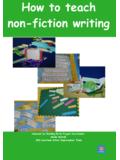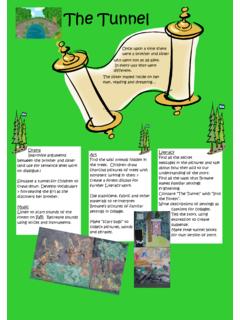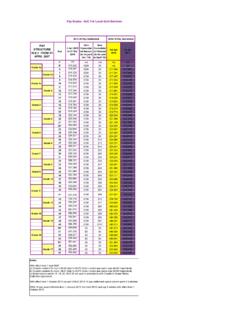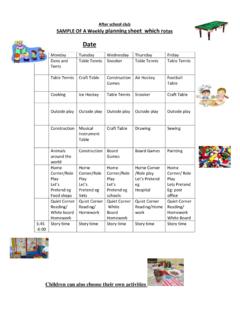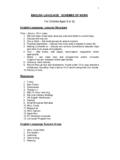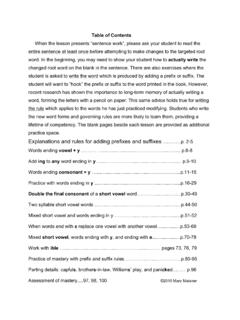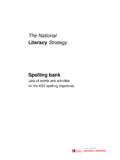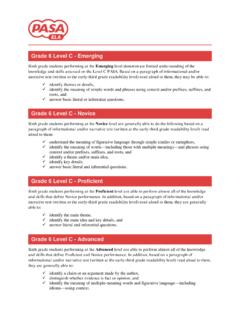Transcription of How Words Work: Morphological Strategies
1 How Words work : Morphological StrategiesWendy Goldup25 Understanding the Morphological nature of Words andusing Morphological Strategies for reading and spelling isa very efficient way of building excellent literacy students and literacy strugglers often don t getto look at, or understand, Words in this way because theyare too busy struggling with basic on the Morphological structure of Words isuseful in many ways: It gives insight into word meanings and history whichsome students find helpful and interesting. It improves vocabulary knowledge. It often grabs the attention of the struggler who hasgiven up on ever becoming a better speller. It is a fresh and different approach for students forwhom the phonological route has been unsuccessful;an antidote to phonics fatigue.
2 I have used the approach outlined here with individualstudents aged 9 years and over, with adults in groups often, and most successfully with two groups of six boysaged between 10 and 15 at a specialist EBD unit. I devised the programme myself and named it HowWords work . It incorporates all the principles ofspecialist literacy teaching that work so well for dyslexicstudents and others who struggle with literacy. Theprinciples are: It is structuredbuilding hierarchically from common,well-known and easily grasped information to moredifficult concepts. It is cumulativein that what has been learnt re-appears and is used in many different ways;previously learnt information is kept under continuousreview. It is multisensoryusing movement and manipulation,cursive writing, verbalisation, reading and spelling in alinked way.
3 The teaching is by directed discovery. Students areled to the information they need by carefully structuredstimuli; they discover and so own the new knowledge. It offers back-up memory supportusing concretereminders of concepts describe here some starter sessions for group work andthen show some examples of materials from Stages of the ProgrammeIn the very first session I have found it useful to take asimple, easily understood base word and show studentshow the meaning changes depending on who is doingthe action, at what time etc., by asking some leadingquestions eg I might help you with your work now, whatwould we say if it happened yesterday? (answer helped ) and so on, writing the Words one at a time in alist on the is important that students watch the word stringdevelop in this way rather than be presented with thefinished list the latter would hold far less ask what is the commonality in all the Words (help) andwhether it is always spelled in the same way (yes).
4 Together we then examine bits that fix on to the front ofthe base word eg un- and see how many Words we canthink of that begin with un-. We can then attempt todiscover how un- changes the meaning of Words . We carry on examining other bits in the same way, , -fuletc. At this early stage I deliberately use theterminology bits that fix on to the front of the base word and bits that fix on to the back of the base word as Idon t want to scare them away with terms that sounddifficult to remember and understand. Correctterminology will come later. At the end of the session I draw attention back to thehelp list and ask the students how many bits were usedto form all the Words in the list. It is a revelation to manythat the answer is just 8 bits.
5 In the next teaching session I give students a little bagcontaining those 8 bits on small cards and ask them tospread them out on the of Words provided by students and written onboard by teacher, one by one, in response to leadingquestionshelphelpshelpinghelpedhe lpfulunhelpfulhelplesshelperDyslexia Review Spring 2010, Volume 21 Number say Words and they make them by pushing students are pleased to be making Words that theymight not recognise in print and cannot spell add to the multisensory nature of this work studentsare now asked to write the list of Words in a supportedway the essential bits are provided, they have toidentify and building in cursive writingWord buildingunhelpfulPart-word tiles for word buildingfuledhelpuninglessersIn following sessions other base Words and affixes areexamined in a similar way.
6 Sometimes the student seesthe new base word and affixes in individual units asdescribed above and is asked to construct the complete Words are presented and thestudent is asked to deconstruct them by cutting, drawinglines in the correct places, or using a simple codingsystem: underline the base word, ring the prefix and boxthe the time seems right I start to substitute the word bit for the correct terms prefix and suffix . I don texpect the students to remember the terms but withfrequent usage they tend to begin to appear in thestudents spoken responses. Thus we have assimilatedsome difficult labels quite Words and affixes that have been studied in thesesessions can be used for comprehension and cloze worksimilar to the example that the sentences can be read to the student by ateacher, assistant or peer.
7 The student is not at any timeexpected to spell these Words unaided. They can feelsecure that all that they need is the base word, ring the prefix, box the tiles for word buildingundercoverlessedundisyingresDysl exia Review Spring 2010, Volume 21 Number time we make a collection of base Words andaffixes studied so that they are not lost from thestudents minds. Three wall charts for the classroommight be made adding new base Words and affixes aswe study them (Fig. 8,) or individual note books aremade. In this way it becomes apparent to students that thesame affixes are used over and over again in many long,multi-syllable Words . They are also led to recognise thatthe spelling of most affixes is stable; one piece ofinformation can help with many, many other the world of Words which has given them so muchtrouble becomes more orderly and less of useful materials for the early stages(Figs 8 & 9).
8 Of word families studied for classroom wallPREFIXES uninenrepredisBASEWORDS helpcoverpresslightjoySUFFIXES sedingfullessmenty Example of cloze sheetcoverresuneddisingunderableyThe detective works ..at a nightclub in are always trying to ..new ways tocure will not be paid if the jewels table .. is left .. attracts heart attack victim made a good ..We are .. lots of things about Mars fromthe Russian submarine is not ..from thesea amazing .. led to the cure for of useful materials for the early stages of advanced workOnce the students are confident working with basewords and affixes we move on to some less transparentbase units or word roots . The same procedure is usedas in the initial session: I write a word root on the boardand invite the students to suggest other Words containingthat word root and watch the word string develop.
9 I explain the change in terminology parts of wordswhich appear in many longer Words and carry meaning,but are not always Words when they stand alone arereferred to as word roots, rather than base Words whichare meaningful by a few word roots have been studied it is useful tolink in with history work in school and add anetymological perspective to some of our most difficultand seemingly obscure the next five or six sessions we look at a map ofthe British Isles and talk about the original inhabitantsand the various invading groups who settled andcontributed to our language mix. For simplicity s sake IWord root and affixes interruptinterruptiondisruptdisruptiveco rruptcorruptibleerupteruptederuptingrupt ureabruptabruptlyWords printed on small cards for students to cuthope lessthank fulwishingpress ing dresses crossun like lyDOMINOESPAIRSD yslexia Review Spring 2010, Volume 21 Number 228tend to stick to Celts, Romans (Latin and Greek), AngloSaxons, Vikings and Normans but mention otherinfluences if and when they students are given a chart to fill in as the weekspass.
10 A similar master chart is placed on the each group of invaders we look at typical Words andlearn how to find origins of Words in a when we study word families we make anaide-memoir, either a complete word list and pictorialreminder, or just a clue word and picture, to remind us ofthe origin and meaning of the word group (Figs. 13, 13a,13b).window(ME f ON vindauga(vin WIND+ augaEYE) window is a middle English word from Old Norse vindauga meaning wind eyeConcise English Dictionary: 6th EditionWhy is English a difficult language to learn?Tribes/InvadersLanguages closer the Words are to the students everyday life,the more meaningful they will be (Fig. 14). far off seeingmobmovemobile phone moving soundfacmake or dofactory place where things are madeMemory aid: Clue Words and picturespendhangsuspended hanging underMemory aid: Word group and pictorial remindertractorretractdistractcontractex tractsubtractsubtractiondistractionattra ctattractivetractiontractabletractdraw or pulltractorthat which draws or pullsDyslexia Review Spring 2010, Volume 21 Number 229 Examples of games and activities used to extend thiswork (Figs.))

